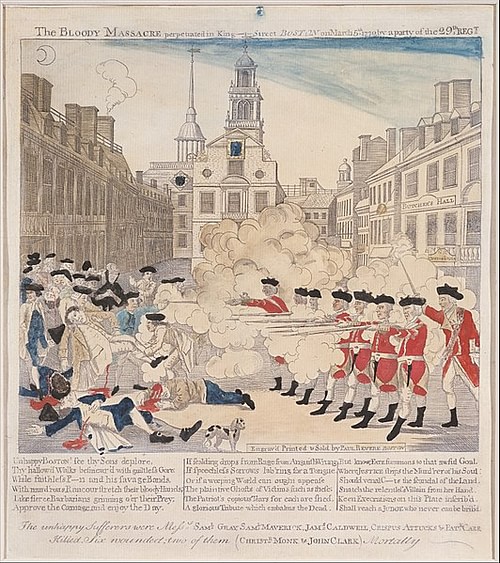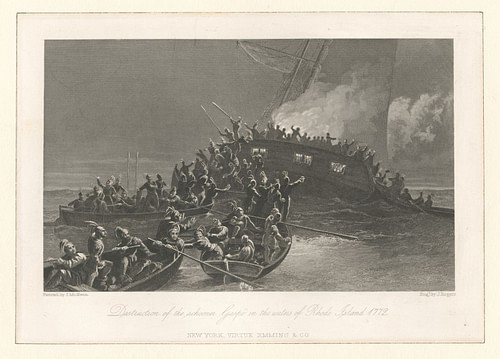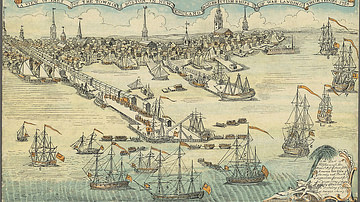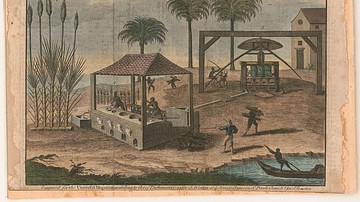
The Gaspee Affair was an incident that occurred on 10 June 1772, when a group of American colonists from Rhode Island seized and burned the Royal Navy schooner HMS Gaspee after it had run aground. The affair contributed to the worsening of relations between Great Britain and the Thirteen Colonies in the early stage of the American Revolution (c. 1765-1789).
At a time when tensions between American colonists and British officials were already high in the wake of the Boston Massacre, an 8-gun Royal Navy schooner, HMS Gaspee, ran aground while chasing an American packet ship just off Warwick, Rhode Island. The Gaspee had been tasked with searching American vessels for smuggled goods but was often judged to be overzealous in its searches; eager to retaliate, a party of Rhode Island colonists associated with the Sons of Liberty rowed out to the trapped schooner in the early morning hours of 10 June 1772. After wounding a naval officer and taking the crew prisoner, the colonists set fire to the Gaspee and sailed back to shore. Though the identities of the culprits were common knowledge, British officials could not secure evidence or testimonies against them, and no arrests were ultimately made. The Gaspee Affair serves as an example of violent colonial defiance of British authority in the leadup to the American Revolutionary War (1775-1783).
Background
In the aftermath of its victory in the Seven Years' War (1756-1763), Great Britain found itself submerged in a sea of postwar debt. Looking for a fresh source of tax revenue, the British Parliament turned its attention toward the Thirteen Colonies of North America, which had thus far avoided being directly taxed by Parliament. Since the war had partially been fought in defense of the colonies, Parliament believed it was only fair that the Americans share in the British Empire's financial burden. To this end, Parliament passed the Sugar Act on 5 April 1764, which placed a tax of 3 pence per gallon on molasses that had been produced outside of the British Empire.
Although the Sugar Act outraged many colonial merchants, it was nothing new. Indeed, it was merely an extension of an existing policy, the Molasses Act of 1733, which had already placed a duty on foreign-produced molasses. But the trouble came from the fact that molasses was such an important commodity to colonial merchants. It made up a vital part of the economies of the New England colonies, where it was used to produce rum, and it played an important role in the lucrative triangular trade, where it was used to purchase slaves. Plantations within the British Empire did not produce enough molasses to satisfy demand, forcing colonial merchants to turn to the French and Dutch West Indies, imports that were subject to the tax.
Prior to the passage of the Sugar Act, colonial merchants smuggled molasses to avoid paying the required duties and bribed British customs officials to turn a blind eye when the illicit cargo was unloaded at port. To put an end to this practice, Parliament weeded out the corrupt tax collectors and replaced them with more reliable men. Stricter policies were enacted to combat smuggling; American merchants and ship captains now had to keep detailed cargo lists that had to be scrupulously verified before any cargo could be offloaded. Anyone caught smuggling was now to be subjected to a vice-admiralty court helmed by a royally appointed judge rather than a jury of peers, while their vessels and cargo were to be confiscated by the Crown.
The St. John Incident
Many colonial merchants disregarded the Sugar Act and continued to engage in smuggling. Now, instead of bribing British customs officials, the smugglers became more discreet; under the cover of darkness, the smugglers would load the illegal cargo into small boats before rowing into inlets, where additional men would be waiting to take the cargo away. Such practices were especially common in the New English colony of Rhode Island, which was especially reliant on molasses for its rum industry. To enforce Parliament's new anti-smuggling laws, the British Admiralty sent several sloops and schooners to patrol the coastlines and inspect the cargos of American vessels. One of these Royal Navy schooners, the 6-gun HMS St. John, was stationed at Newport, Rhode Island, in 1764.
The Rhode Islanders did not take kindly to the presence of the St. John; many colonists sided with the Newport merchants, who had convinced them that the molasses taxes would hurt the colony's economy. The behavior of the St. John's crew did nothing to ease tensions; the British sailors pressed several Rhode Islanders into service and were accused of stealing goods from Newport merchants. Eventually, the crew of the St. John was confronted by a local sheriff and two city councilors. The argument became so heated that the St. John decided to sail out of Newport for its own safety. As it did so, the two city councilors ordered Newport's cannons to fire at the schooner. Although no one was injured in the incident, the fact that civilian authorities fired on a Royal Navy vessel was significant. Merchants in Rhode Island and other colonies continued to flout the Sugar Act and had shown that they were not afraid to stand up to the navy.
HMS Gaspee
In the following years, the relationship between Britain and its thirteen North American colonies continued to deteriorate. In 1765, Parliament passed the Stamp Act, its first direct tax on the colonies; this was vigorously protested by the colonists, who believed that it violated their rights since they were not represented in Parliament. The Stamp Act was rescinded in 1766 but was followed by another series of taxes and regulations called the Townshend Acts in 1767 and 1768. The slogan ‘no taxation without representation' spread across the colonies as a group of political agitators known as the Sons of Liberty continued to lead protests and riots against the taxes. In October 1768, British soldiers were sent to Boston, Massachusetts to keep the peace; tensions between the army and the colonists boiled over on 5 March 1770, when nine British soldiers fired on a crowd of American colonists, killing five, in the Boston Massacre. The massacre increased the rift between Britain and the American ‘Patriots', as the opponents of Parliament's taxes were called.
It was amidst this atmosphere of revolutionary tension that the HMS Gaspee arrived in Rhode Island's Narragansett Bay in March 1772. Like the St. John before it, the Gaspee was tasked with combating smuggling; it was to inspect the cargo of American vessels and seize any contraband that it found. The Gaspee was an 8-gun schooner crewed by 19 men and captained by a naval officer named Lieutenant William Dudingston. Under Dudingston's command, the Gaspee soon gained an ill-reputation amongst the colonists of Rhode Island, who believed that the schooner was exceeding its authority; the Gaspee's crew often boarded and detained American vessels with scant cause and confiscating their cargoes. Since Dudingston and his men were allowed to keep a portion of any cargo that they confiscated, many colonists suspected that the crew of the Gaspee was motivated as much by greed as any sense of duty.
Shortly after its arrival, the Gaspee detained an American sloop called the Fortune, which was carrying undeclared barrels of rum. Dudingston ordered that the Fortune and the rum be sent to Boston, where the American crew would also be sent for trial by a vice-admiralty court. This enraged Rhode Island authorities, who claimed that Dudingston's actions were illegal; under the Rhode Island Royal Charter of 1663, any arrest that took place within Rhode Island territory must be tried in the colony. Local resentment against the Gaspee continued to grow until a Rhode Island sheriff went so far as to threaten Dudingston with arrest for his transgressions.
Insulted by this challenge to his authority, Dudingston took the matter up with his superior, Admiral John Montagu. Montagu took Dudingston's side and wrote an angry letter to the sheriff and to Governor Joseph Wanton of Rhode Island, in which he threatened to hang as a pirate anyone who tried to rescue a vessel confiscated by naval authorities. Governor Wanton responded with a letter of his own, in which he implied that Lieutenant Dudingston was the true pirate. Wanton told Montagu that it was not the place of the Admiralty to give orders to colonial governors: "as to your advice not to send the sheriff onboard any boat of your squadron, please know that I will send the sheriff of this colony at any time, and to any place, within the body of it, as I see fit" (Middlekauff, 219-220). With the tensions in the colonies already high due to the broader political matters of the American Revolution, the perceived tyranny of men like Dudingston was too much for many Rhode Islanders to bear. Some of them resolved to take matters into their own hands and solve the Gaspee problem once and for all.
Burning of the Gaspee
On 9 June 1772, the Gaspee was in close pursuit of the Hannah, a packet ship that Dudingston suspected was carrying smuggled goods. At some point during the chase, the Gaspee ran aground in shallow water on the northwestern side of what is now Gaspee Point near Warwick, Rhode Island. While this could have been accidental, the crew of the Hannah would later take credit for intentionally luring the Gaspee into the shallows. Whatever the case, the crew of the Gaspee was unable to free the ship, leaving Dudingston no choice but to wait until high tide to bring the vessel back afloat.
Meanwhile, news of the Gaspee's predicament reached Providence, Rhode Island. At 10 p.m., the local chapter of the Sons of Liberty held a meeting in a tavern, where it was decided that they would take advantage of this opportunity. Led by John Brown, an influential Rhode Island merchant, the Sons of Liberty melted down some lead into bullets before setting out in longboats to confront the British schooner. Brown's party finally approached the Gaspee close to 2 a.m. on 10 June; the colonists would later claim that they had eight longboats and 64 men, while Dudingston later asserted that there were dozens of longboats and over 250 colonists.
In any case, the Rhode Islanders climbed aboard the schooner and took the crew by surprise. Except for one lookout, the crew had been sleeping below deck, their weapons locked away inside a chest. The British sailors woke up, startled, to find several armed colonists aboard their ship; one of the colonists, perhaps Brown himself, claimed to be a sheriff and said he had a warrant for Dudingston's arrest. When the short-tempered Dudingston tried to resist, someone fired a gun, wounding Dudingston in the groin; seeing their commander wounded, the other British sailors gave up any thoughts of resisting. Brown's party proceeded to read through the ship's papers before loading everyone into the longboats. The colonists set fire to the Gaspee before rowing away, likely watching with satisfaction as the schooner burned.
Investigation
The colonists rowed to shore where they dumped off Dudingston and the other sailors before making their way back to Providence. Dudingston spent the next few days tending to his wound but was soon arrested by the sheriff, who charged him with the illegal seizure of cargo. Admiral Montagu was livid when he heard what had happened and had to pay a steep fine to secure Dudingston's release from jail. Montagu then sent Dudingston back to England, where he was court-martialed for his loss of the Gaspee. Dudingston was ultimately acquitted of all wrongdoing and, in 1773, earned a pension for the wound he had received.
Meanwhile, the Admiralty was predictably outraged that a Royal Navy schooner was seized and burned with impunity. Montagu launched an investigation into the incident, hoping to uncover the names of those who had attacked the Gaspee; Montagu was adamant that, once uncovered, the perpetrators should be sent to England where they would stand trial for treason. Despite his earlier animosity toward Montagu, Governor Wanton condemned the attack and cooperated with the investigation. Wanton offered 100 pounds to anyone who came forward with information that could lead to arrests; shortly thereafter, the British Crown increased this reward to 500 pounds. In January 1773, a commission was appointed to investigate the matter, with Governor Wanton himself placed at its head. It is not surprising, then, that the commission's first order of business was to issue a report declaring that the civil officials of Rhode Island were guilt-free.
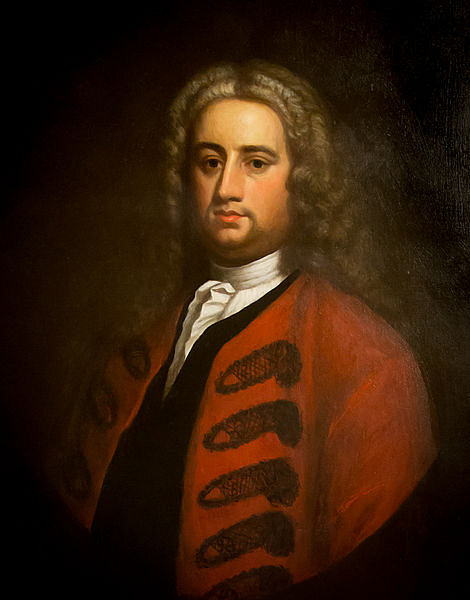
After months of interviews and investigations, the commission was able to find only one serious eyewitness: an indentured servant of African and Native American descent named Aaron Briggs. Briggs claimed to have been present at the burning of the Gaspee and was able to provide the commission with five names of important Rhode Island merchants, including that of John Brown. Governor Wanton wasted no time calling Briggs' testimony into question. He summoned the owners of the farm on which Briggs was indentured; the owners gave testimonies of their own in which they claimed that Briggs had been on the farm during the night of 9-10 June and could not have been present for the raid. This was enough for Wanton to label Briggs an imposter and throw out his testimony, despite Montagu's belief that the testimony was still valid. Briggs, meanwhile, had felt threatened by the powerful Rhode Island merchants he had implicated, leading the British navy to take him into its protection. In the end, no one was charged for the destruction of the Gaspee, nor for the wounding of Lieutenant Dudingston.
Aftermath
Although no American colonists were punished for the burning of HMS Gaspee, colonial leaders still found reason to be alarmed. The investigating commission had been granted the authority to extradite any potential prisoners to England, along with any witnesses and evidence for trial. The colonists understood this to be a violation of another of their rights, to be tried only before a jury of peers. Colonial newspapers wasted no time reporting the latest British tyranny, reigniting a political conversation that had lain more or less dormant since the Boston Massacre.
In the colony of Virginia, leading figures such as Thomas Jefferson, Richard Henry Lee, and Patrick Henry decided that an organization was needed to safeguard the Americans' right to a fair trial. In March 1773, Virginia created a permanent intercolonial committee of correspondence whose job it was to communicate with the legislatures of other colonies and to coordinate responses to actions deemed threatening to American liberties. Within a year, every colony except Pennsylvania had formed a similar committee; the Americans had already begun to join together in a common cause.
While the Gaspee Affair remains one of the lesser-known stories of the early American Revolution, it is significant, nonetheless. It raised tensions between Britain and the colonies at a time when relations were already quickly deteriorating and proved that violent action could be successfully taken against the British military. Only 18 months after the Gaspee Affair, the American colonists would commit a much more consequential act of defiance in the Boston Tea Party, which further set the colonies down the path toward war.

